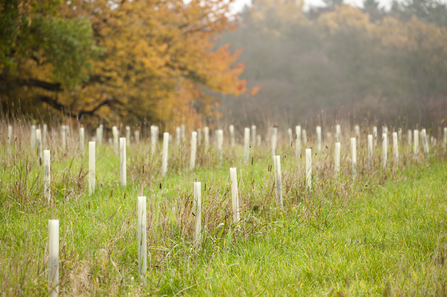
Tree planting by Ross Hoddinott
Woodlands are one of the most important habitats for wildlife in the UK and Suffolk Wildlife Trust is working hard to ensure that the region's ancient woodlands are protected and sensitively managed. In addition the Trust is supporting landowners and farmers to create new sites that have the potential to sustain a wide range of birds, mammals, invertebrates, reptiles and plant life.
With a little care and a lot of hard work, it is possible to plant trees and shrubs to create an area which looks, smells and feels like a real woodland within 20 to 30 years.
Choosing a place to plant your wood
New woods can be planted in a wide variety of places from school grounds and parks to farmland, or as part of an industrial or housing development. Areas that are close to existing woodland can also be allowed to grow up naturally, although that approach will still need some management.
Wherever you choose to create a woodland, remember these points:
• Do not plant your wood on an area that is already good for wildlife. For instance, a wildflower meadow would be destroyed if trees were to grow over it
• Find out where services, such as gas and electricity, run and plant well away from them
• Avoid planting wide rooting trees such as willow and poplars near buildings
• Think about the shade your trees will cast
• Don’t plant big trees such as oak or ash on a small site
• Choose trees which grow locally. Try not to plant trees that are not found naturally in your area. New woods should be planned to reflect natural woodland with different layers of trees, shrubs and wildflowers.
The diagram shows a suitable planting plan to create this natural structure.
Creating a diverse structure
One of the things that makes natural woodland so attractive to wildlife is its diversity.
• Trees should be planted at 2 - 3 metre intervals. Shrubs should be planted between the trees at distances of 1 – 1.5 metres.
• Plant light-loving trees and shrubs, such as blackthorn, dog rose and field maple at the edges. Shrubs which tolerate shade, such as hazel, holly, hawthorn and wild privet, should be planted in the centre
• Plant tall-growing trees such as oak and ash to form the canopy of your woodland. These will reach a reasonable height in about 25 years!
• To create a woodland effect more quickly, plant fastgrowing trees such as birch, willow or alder. These will create a woodland effect in about 10 – 15 years.
Improving existing areas of trees
Simple changes can transform old trees in parks and gardens into new woodlands for wildlife:
• Allow the grass around the base of the old trees to grow up. With luck woodland wildflowers will begin to blossom
• Plant shrubs which enjoy shade, such as hazel and holly, beneath the trees
• Plant some replacements for the existing trees. Make sure they are of the same type. For example, if you have an area of oak, plant a sprinkling of oak seedlings among the shrubs
• Try to make sure you keep the new trees and shrubs well watered – conditions could be hostile to start with
Looking after a new wood
It is important to look after a newly planted wood by:
• Pruning shrubs down to 40-60cm in the first winter after planting - this will stimulate bushy growth and provide cover and nesting sites for wildlife
• Watering regularly, especially during the first summer. Shrubs may die and will need to be replaced during the following winter
• Weed around new trees and shrubs to stop competition for food, water and light from brambles and grasses. This problem can be dramatically reduced by mulching around the newly planted trees with bark chippings
• Thinning trees - as your woodland develops it may start to become crowded, so you will have to thin the trees. This involves removing the smaller or weaker trees and shrubs to give the more successful ones a chance to survive. Refer to our section on woodland management for more details.
Making your wood a better place for wildlife
Once the trees and shrubs have become established, there are lots of things you can do to make your wood a better place for wildlife:
• Introduce dead wood – this is very important to woodland wildlife. Log piles are ideal and will appeal to invertebrates, amphibians, reptiles and mammals - and all of the species that feed on them
• In urban areas, you can plant a mix of native woodland wildflowers. Primroses, violets, bluebells, wood anemone and ramsons may do well
• If your wood is big, you can create open areas such as glades and rides. These are good for bringing light and warmth into your woodland. This will be attractive to many plants and animals, especially butterflies.
• It is important to consider the long-term future and management of your woodland
Examples of trees and shrubs to plant
Shrubs — blackthorn, dog rose, field maple, hazel, holly, hawthorn and wild privet.
Canopy trees — oak, ash and wild cherry.
Fast-growing trees — birch, alder and willows.
